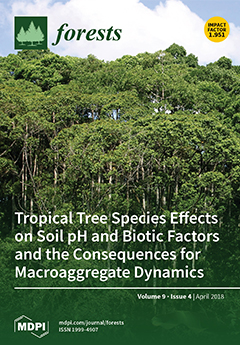1
USDA Forest Service, Northern Research Station, 359 Main Rd., Delaware, OH 43015, USA
2
Biological Sciences, Department of Ecology and Evolution, University of Illinois at Chicago, 845 W, Taylor St, Chicago, IL 60607, USA
3
Chicago Botanic Gardens, Department of Plant Science, 1000 Lake Cook Rd, Glencoe, IL 60022, USA
4
The Morton Arboretum, 4100 Illinois Route 53, Lisle, IL 60532, USA
5
Department of Biology, Miami University, 316 Pearson Hall, Oxford, OH 45056, USA
6
USDA Forest Service, Allegheny National Forest, 4 Farm Colony Dr., Warren, PA 16365, USA
7
The USDA Forest Service, Northern Research Station, P.O. Box 267, Irvine, PA 16329, USA
Abstract
Forest resources face numerous threats that require costly management. Hence, there is an increasing need for data-informed strategies to guide conservation practices. The introduction of the emerald ash borer to North America has caused rapid declines in ash populations (
Fraxinus spp. L.).
[...] Read more.
Forest resources face numerous threats that require costly management. Hence, there is an increasing need for data-informed strategies to guide conservation practices. The introduction of the emerald ash borer to North America has caused rapid declines in ash populations (
Fraxinus spp. L.). Natural resource managers are faced with a choice of either allowing ash trees to die, risking forest degradation and reduced functional resilience, or investing in conserving trees to preserve ecosystem structure and standing genetic diversity. The information needed to guide these decisions is not always readily available. Therefore, to address this concern, we used eight microsatellites to genotype 352 white ash trees (
Fraxinus americana L.) across 17 populations in the Allegheny National Forest; a subset of individuals sampled are part of an insecticide treatment regimen. Genetic diversity (number of alleles and He) was equivalent in treated and untreated trees, with little evidence of differentiation or inbreeding, suggesting current insecticidal treatment is conserving local, neutral genetic diversity. Using simulations, we demonstrated that best practice is treating more populations rather than more trees in fewer populations. Furthermore, through genetic screening, conservation practitioners can select highly diverse and unique populations to maximize diversity and reduce expenditures (by up to 21%). These findings will help practitioners develop cost-effective strategies to conserve genetic diversity.
Full article





